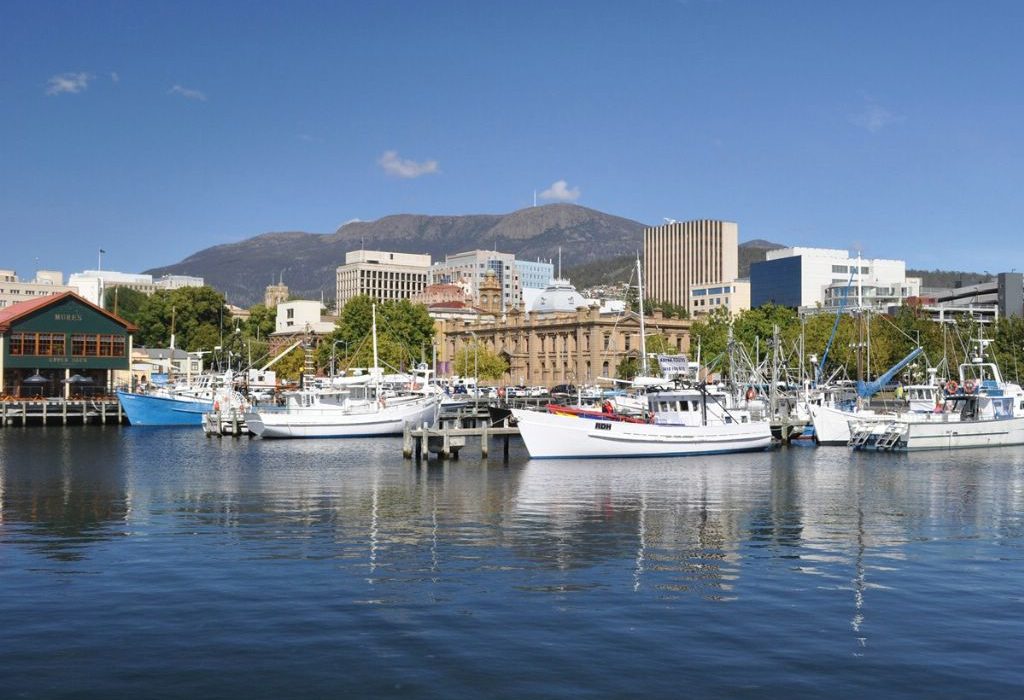
You might also like:
“I can’t get over this place. It’s got everything.”
The middle-aged man has spiky hair and an unusual accent. We’re both standing atop the boulder-strewn summit of Mt Wellington (1270m), a huge mound of dolerite that looms above Hobart city, the Derwent River and its apparently endless estuary. There’s a cold wind swirling about the mountain, but the sky is clear blue. The man raves on.
“I’ve seen some great landscapes here, and some great art. Wine too. Rainforests, beaches …” His voice fades away, he’s speechless with admiration for the Tasmania he’s discovered.
“Where are you from?” I ask. “Europe?”
He shoots me a surprised look. “No, mate. Melbourne.”
Melbourne is an hour by air from Tasmania.
This visitor’s reaction is not untypical. Many people on the mainland of Australia have never set foot on their nation’s southernmost state. For years Tasmania had a reputation as a home only for backwoodsmen and inbreds. There was a mainland joke that the people of Tasmania had two heads. You could even buy souvenir T-shirts which had holes for the two.
That joke is badly out of date. Tasmania is now drawing not only visitors from Australia’s mainland, but also settlers yearning for a less hectic way of life and circumventing the grossly inflated property prices of Melbourne, Sydney and Brisbane. A large modern house in Hobart (population 218,000) or Tasmania’s northern city of Launceston (pop. 106,000) can be obtained for $750,000, and forests, beaches and vineyards are less than an hour’s drive away from either city.
This may not last. Already word has got around Australia’s other states. “Go south, young man.” Hobart’s traffic problems at rush-hour, especially approaching the high bridge over the Derwent, are almost as bad as Auckland’s, and new suburbs are proliferating on the undulating hills of the city’s eastern shore.
Yet Hobart remains a charming, sophisticated city. All roads lead down to its waterfront.
Two one-way highways, Macquarie St and Davey St — both commemorating colonial governors — separate the CBD from the wharf area. Once there, it’s a restful area to wander in, except on Saturday mornings, when Salamanca Place heaves with market stalls and shoppers. Parking at this time is difficult, so it’s best to leave the car elsewhere and walk the short distance to the market.
Much less hectic is the Sunday morning Farm Gate Market in the CBD’s Bathurst St, where Tasmanian organic produce of every variety is on sale. Farmed oysters and fine cheeses, Tasmanian specialties, are recommended.
The waterfront is lined with dignified heritage buildings, cafes and art galleries. Its sheltered harbour is home to tall ships, cruising yachts and ferries. Overlooking the harbour is Battery Point, a maze of narrow lanes and exquisite sandstone Georgian cottages dating back to Hobart’s dark, early 19th-century beginnings as a settlement of penal administration.
Hobart makes the most of its eventful past. Opposite Constitution Dock is the Maritime Museum of Tasmania, which contains stark reminders of the many shipwrecks that litter the island’s coasts, Bass Strait especially. Then there was the tragedy of 1975, when a zinc ore carrier blundered into some piers of the Derwent Bridge, bringing parts of it crashing into the river, killing 12 people.
Monuments to a more genteel past can be seen in the fine old Victoria-era houses on the hills of North Hobart, all of which are overlooked by the brooding brow of Mt Wellington.
East of the city centre and alongside imposing Government House are the Royal Tasmanian Botanical Gardens, which contain many of the state’s unique trees, shrubs and flowering plants.
What the Guggenheim Museum did for Spain’s once-decaying port town of Bilbao, the Museum of Old and New Art has done for Hobart. Known as Mona, this gallery’s avant-garde installations are eclipsed by the amazing space that contains them.
A 20-minute ferry ride upriver from Hobart’s waterfront, the gallery was gouged out of the sandstone bank of the Derwent. Most of the space is underground, its walls and roof supported by massive concrete beams. A dusky vault whose contents vary from the brilliant to the unfathomable, it has brought tens of thousands of visitors to Hobart every year since it opened in 2010.
Catch Hobart while you can.
When the rest of the Melburnians discover the place, this lovely city will never be the same.
Getting there: Save $250pp on all AAT Kings’ Tasmania guided holidays of six days or more, booked and paid before June 30 for travel between September 2017 and May 2018.
Sоurсе: nzherald.co.nz
